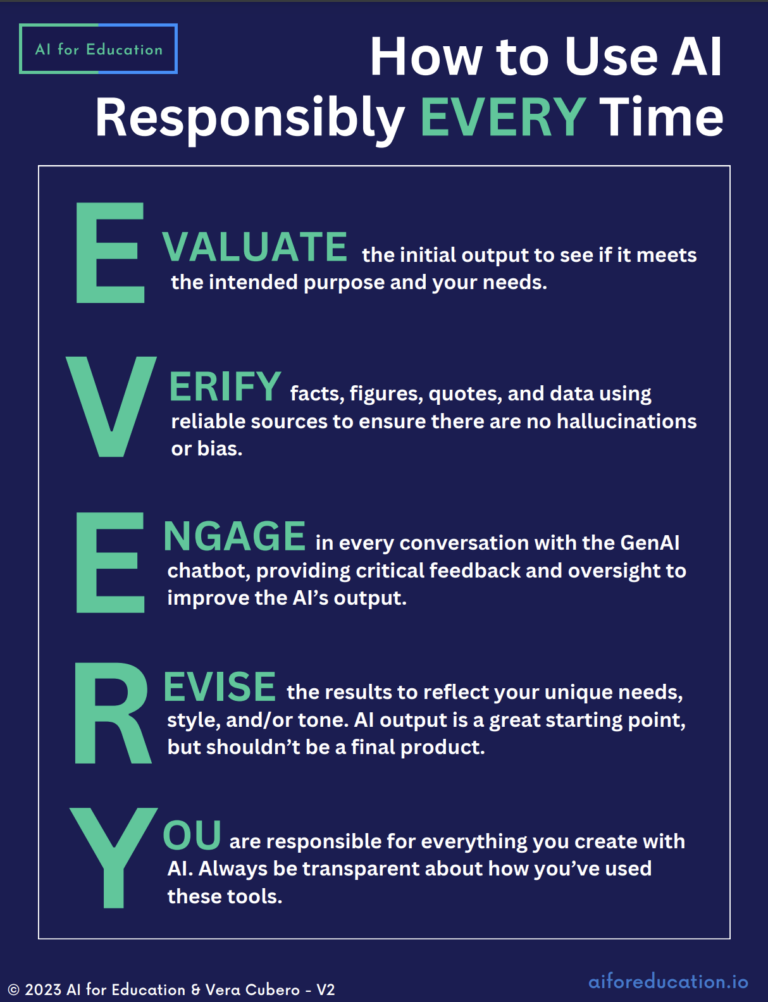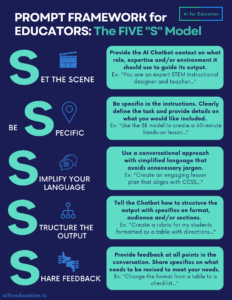
AI prompt writing is a skill that teachers and students should refine. AI prompts are the instructions that you give to AI systems to generate content. The quality of the content that is generated is directly related to the quality of the prompt.
Remember AI’s strengths and limitations during prompt writing. AI is great at repetitive tasks and tasks that involve analyzing a lot of data. It is great at helping generate lesson ideas, quiz questions, and rubrics. It is not as good at providing trustworthy, vetted data.
Writing Techniques
Despite their impressive capabilities, many AI systems lack a nuanced understanding of human intent. They rely heavily on training data. While they can identify patterns, they may have a limited contextual understanding of the broader context, cultural nuances, implied meanings, sarcasm, and humour. AI systems often take things literally.
This is why providing clear and specific instructions is crucial when interacting with AI systems. You should use:
- Precise Language
- Details about your role and intent
- Refinement prompts
- Contraints and parameters to limit output (in terms of word count, reading level, or sources it pulls from).
- Keywords and tags (e.g. UDL, STEAM, the reading level of a specific program, etc.).
REMEMBER: Data privacy and security are important. Your prompts should never include confidential information!
Resources for Teachers

January 21, 2025, Practical AI webinar with Digital Moment. Recording to come.
This webinar is hosted by LEARN – RÉCIT Provincial Service for the Anglophone Community.
Resources:
The “Five S” Model for prompt writing pictured on the left was developed by AI for Education.
This a framework was designed to help educators and students enhance their skills in prompt engineering. It outlines a structured approach to creating effective prompts that can significantly improve the utility of AI tools in educational settings.
Teaching Prompt Writing in the Classroom
Here are some activity ideas to explore AI prompts with your students:
- Provide scenarios or prompts that raise ethical concerns (e.g., AI-generated misinformation, plagiarism, bias in AI outputs). Have students brainstorm potential “guardrails” or ethical guidelines for prompt writing. Then, discuss how prompts can be used to promote responsible and ethical AI use.
- Be the AI: A collaborative activity where students give each other increasingly complex and challenging prompts. (Eg. Draw a bee, draw a bee in a flower, draw a bee in a flower in a girl’s hair. ) Discuss the importance of specific terms and prompt revisions.
- Students analyze existing pieces of creative writing (poems, stories, songs) and try to reverse-engineer the potential AI prompts that might have generated them. In doing so, they need to specify audience, writing style, characters, and other linguistic elements.
It is critical for teachers and students to be critical of anything generated by artificial intelligence or AI. Here are some points to consider and helpful resources.
Accuracy
AI can generate misinformation or hallucinate resources and facts that aren’t real. Teachers and students must meticulously cross-reference content with authoritative sources to ensure reliability. You should:
- Reference official curriculum guides and academic standards to ensure the content matches curriculum standards and learning objectives.
- Verify information against multiple reputable sources, such as textbooks and academic journals.
If you are using AI to generate activities for students, take steps to ensure the AI systems are pulling from provincial curriculum documents.If you want to generate a text about a specific topic, ask the AI system for references and verify those references before using the content.
Helpful Tip: When writing prompts, include constraints and parameters. Some systems even allow you to upload the documents from which you want to pull information. You can then use a prompt asking the AI system only to pull information and ideas from that specific document. Just be sure to double-check it follows your instructions!
Bias
Examining all outputs for potential biases is crucial in creating fair and representative educational materials. You should:
- Analyze the content for cultural representation, misrepresentation & misinformation.
- Check for gender-balanced language and examples.
- Identify and correct any potential stereotypes.
- Ensuring diverse perspectives are represented
- If you want to generate content related to a specific social group or historical event, cross-check the information and, if necessary, ask someone from the social group to vet the content. (eg. If you are asking about AI to generate an activity that includes Indigenous Perspectives, ensure the content is not pan-Indigenous and ask someone from the specific Nation you are learning about to vet the content).
The goal is to create inclusive materials that speak to and respect all students, regardless of their background, identity, or experience.
Teaching About Assessing AI Output in the Classroom
- Have students practice analyzing different AI outputs that have been previously generated. Have them create tools and guidelines to assess AI for accuracy and bias.
- Students can practice cross-referencing and fact-checking materials that the teacher generates.
- Bias detection: students practice identifying subtle discriminatory language and excluding diverse perspectives in ai outputs. They discuss how bias can be embedded in seemingly neutral text.
- Generate fake content related to a specific scientific concept or historical event, then have the students try to establish gaps or misinformation to create a more truthful representation.










